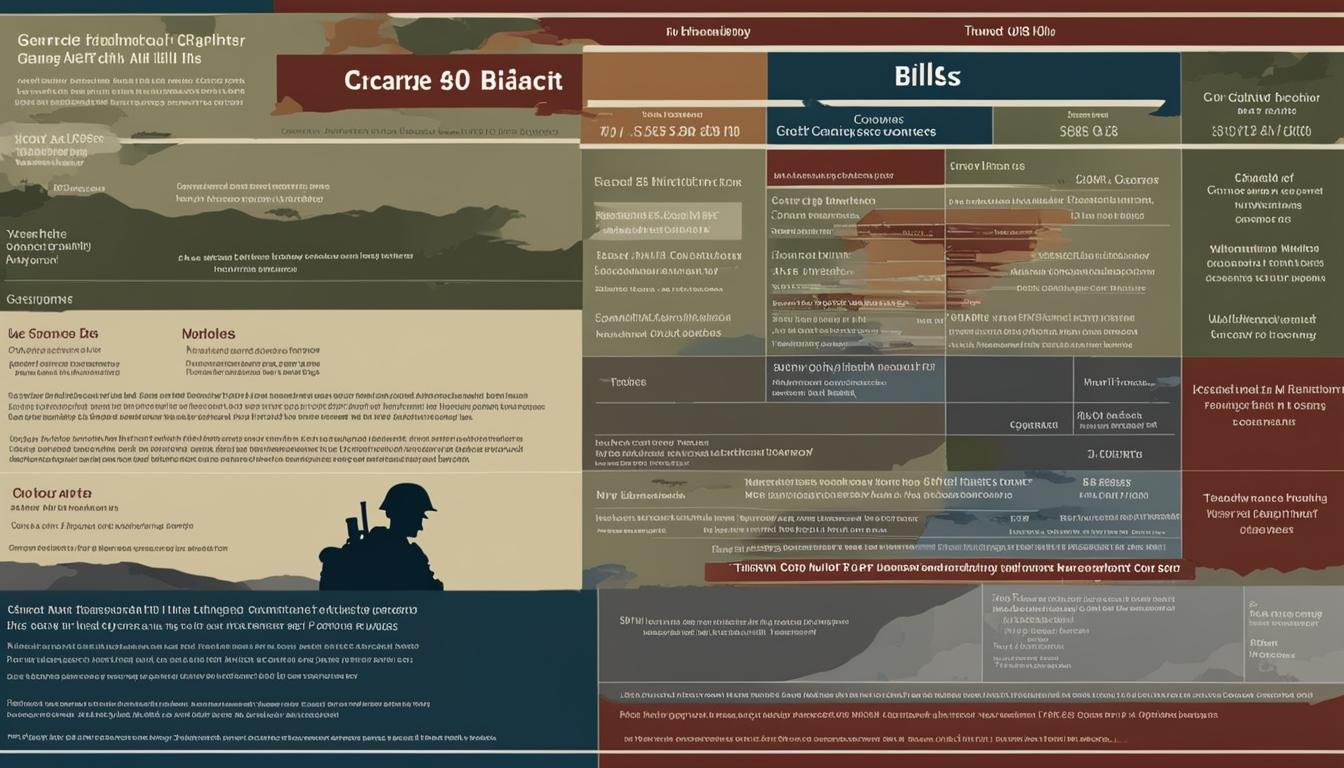Welcome to our guide on comparing the Post-9/11 GI Bill and the Montgomery GI Bill. If you’re a veteran or currently serving in the military, understanding the eligibility requirements and benefits of these two GI Bills is crucial in making informed decisions regarding your education and future. In this section, we will outline the differences between the two bills and highlight the key factors you need to consider.
Key Takeaways
- The Post-9/11 GI Bill eligibility is determined by service start date and requires an honorable discharge, minimum active duty or service-connected disability.
- The Montgomery GI Bill Active Duty (MGIB-AD) eligibility depends on service start date and length of service, while the Montgomery GI Bill Selected Reserve (MGIB-SR) is available to those who serve in the Selected Reserve for 6 years or as an officer.
- Veteran Readiness and Employment (VR&E) benefits have no specific service requirements.
Comparing the Payments and Time Limits of the Post-9/11 GI Bill and Montgomery GI Bill
When considering your options for educational benefits, it’s essential to understand the differences in payments and time limits between the Post-9/11 GI Bill and the Montgomery GI Bill. These two programs offer distinct financial assistance for veterans pursuing higher education. Let’s take a closer look at how they compare.
Post-9/11 GI Bill Payments: The Post-9/11 GI Bill provides a comprehensive package of benefits to eligible individuals. One of the notable features is the direct payment of tuition and fees to the school, ensuring veterans have their educational expenses covered. Additionally, recipients are entitled to a monthly housing allowance based on the cost of living in the area where they attend school. This stipend assists veterans with their living expenses while pursuing their education. Furthermore, the Post-9/11 GI Bill includes a books and supplies stipend, ensuring veterans have the necessary materials for their courses.
Montgomery GI Bill Payments: In contrast, the Montgomery GI Bill offers a monthly check directly to the student. While the Post-9/11 GI Bill focuses on providing financial support to cover specific educational expenses, the Montgomery GI Bill offers veterans more flexibility in how they allocate their funds. However, it’s important to note that the Montgomery GI Bill does not provide housing allowances or book stipends. The rates for payments may also differ between the Montgomery GI Bill Active Duty (MGIB-AD) and the Montgomery GI Bill Selected Reserve (MGIB-SR).
Now that we’ve explored the payment differences, let’s take a closer look at the time limits for these GI Bill benefits. (Insert relevant H3 if necessary)
| Post-9/11 GI Bill | Montgomery GI Bill Active Duty (MGIB-AD) | Montgomery GI Bill Selected Reserve (MGIB-SR) | |
|---|---|---|---|
| Expiration of Benefits | No expiration | 10 years from discharge | 14 years from eligibility date |
| Time to Use Benefits | 15 years from discharge/release | 10 years from last discharge/release | 14 years from eligibility date |
Time Limits for GI Bill Benefits: The Post-9/11 GI Bill offers the advantage of no expiration of benefits, allowing veterans the flexibility to use them when the timing is right. However, there is a 15-year time limit from discharge/release to utilize the benefits. On the other hand, the Montgomery GI Bill benefits have specific time limits. The MGIB-AD benefits expire 10 years from the date of discharge, while the MGIB-SR benefits are available for 14 years from the eligibility date.
Understanding the payment differences and time limits can help you make an informed decision when choosing between the Post-9/11 GI Bill and the Montgomery GI Bill. Assessing your financial needs and long-term educational goals will be crucial in determining which program best suits your situation.
What are the differences in eligibility and benefits between the Post-9/11 GI Bill and the Montgomery GI Bill?
The main difference in montgomery gi bill eligibility and benefits lies in the eligibility requirements. The Post-9/11 GI Bill offers benefits to those who have served after 9/11, while the Montgomery GI Bill is available to active duty members who have contributed to the program for at least two years.
Conclusion: Choosing Between the Post-9/11 GI Bill and Montgomery GI Bill
When considering which GI Bill to choose, it’s essential to evaluate your educational goals and service history to make the best decision. The Post-9/11 GI Bill offers a comprehensive range of financial assistance, including a higher tuition payment, housing allowance, and books and supplies stipend. Moreover, it provides the option to transfer benefits to your dependents, ensuring their educational needs are also met.
On the other hand, the Montgomery GI Bill may be more suitable for part-time students or individuals seeking online classes with lower credit costs. While it doesn’t offer housing allowances or book stipends, the Montgomery GI Bill can provide a monthly check directly to the student. This simplicity and flexibility can be advantageous for those pursuing a less traditional educational path.
Additionally, the Montgomery GI Bill offers a buy-up program specifically designed for active-duty servicemembers, allowing them to increase their benefits. This program ensures that if you decide to transition from active duty to pursuing further education, you can enhance your financial support through the Montgomery GI Bill.
In summary, when making the decision between the Post-9/11 GI Bill and Montgomery GI Bill, carefully assess your circumstances, educational aspirations, and financial needs. Consider the benefits provided by each bill and choose the one that aligns most closely with your goals. Both GI Bills offer valuable educational benefits, and by making an informed choice, you can maximize the support available to you as you pursue your educational journey.



